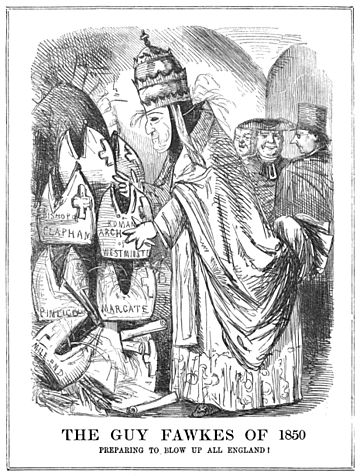Universalis Ecclesiae facts for kids
Universalis Ecclesiae was an important official letter from Pope Pius IX on September 29, 1850. This letter, called a papal bull, brought back the normal system of Roman Catholic bishops and dioceses (church areas) in England. This system had been stopped when the last Catholic bishop died during the reign of Elizabeth I. The new dioceses were given different names because the old names were already being used by the Church of England. This decision made many Protestants in England very angry, leading to strong anti-Catholic feelings.
Contents
History of Catholic Leaders in England
For a long time, Catholics in England did not have their usual church leaders. Instead, their care was first managed by a priest called an archpriest. Later, from 1623 to 1850, they were looked after by special bishops called apostolic vicars. These vicars were bishops of old, honorary church areas, and they governed for the Pope, not in their own name.
At first, there was only one vicar for all of England. Over time, this number grew to four, covering different parts of the country like London, the Midlands, the North, and the West. By 1840, there were eight such areas.
Things started to get better for Catholics in England and Wales after the Roman Catholic Relief Act 1829. This law gave them more rights. Many people in the 19th century became Catholic, and millions of Irish Catholic immigrants also moved to England. Because of this, Catholics grew to be about 10% of England's population.
Pope Pius IX saw that the number of Catholics was growing and that there were fewer problems for the Catholic faith. So, he decided it was time to bring back the normal church structure. He wanted England to have the same kind of church government as other countries.
The Pope's letter created new dioceses. For example, the London area became the Archdiocese of Westminster and the diocese of Southwark. The North became the diocese of Hexham. In total, the new system had one main archbishop and twelve other bishops.
| Diocese | Bishop |
|---|---|
| Westminster | Nicholas Patrick Stephen Wiseman |
| Birmingham | William Bernard Ullathorne OSB |
| Nottingham | Joseph William Hendren O.F.M. |
| Shrewsbury | James Brown |
| Newport and Menevia | Thomas Joseph Brown, O.S.B. |
| Liverpool | George Hilary Brown |
| Beverley | John Briggs |
| Salford | William Turner |
| Southwark | Thomas Grant |
| Plymouth | George Errington |
| Northampton | William Wareing |
| Hexham | William Hogarth |
| Clifton | Thomas Burgess |
New Dioceses, Not Old Ones
The new Catholic dioceses in England were given fresh names. They did not use the names of the old dioceses from before the English Reformation. For example, there was no longer a Catholic Archbishop of Canterbury. Instead, the Diocese of Westminster was created with its own archbishop.
The main reason for creating new dioceses was a law from 1829. This law said that only the clergy of the Protestant Church of England could use the old church titles.
A famous Catholic leader, John Henry Newman, spoke about this change. He said that while the old great church areas like Canterbury and York were gone, new ones like Westminster and Nottingham would rise up. He believed that new saints and teachers would come from these new places.
It's interesting to note that when the Catholic church system was brought back in Scotland in 1878, they did use the old diocese names. This was because the main church in Scotland (the Reformed Church) did not have bishops using those names. In Ireland, the Catholic Church had always kept its old church areas, even though the Church of Ireland also claimed them.
Public Reaction to the Change
When the Pope's letter was made public, many people reacted with anger. The new Archbishop of Westminster, Nicholas Wiseman, wrote that "Catholic England has been restored to its orbit." This statement made some people even more upset.
Anti-Catholic Feelings
Newspapers published articles with titles like "The Blight of Popery." Many "No Popery" protests happened across England, and Catholic church windows were sometimes broken. Guy Fawkes night became a time for people to show their anger. They burned effigies (dolls) of the new Archbishop Wiseman and the Pope. There were large protests in London and other cities.
The Prime Minister at the time, Lord John Russell, also spoke out against what he called the "Papal Aggression."
In response to the public outcry, Parliament passed the Ecclesiastical Titles Act 1851. This law made it illegal for anyone outside the Church of England to use any bishop's title for a city or area in the United Kingdom. However, this law was not really enforced and was removed 20 years later.
Later Changes to the Dioceses
Over the years, some adjustments were made to the new dioceses. In 1861, the Hexham diocese changed its name to Hexham and Newcastle. In 1878, the Beverley diocese was split into two new dioceses: Leeds and Middlesbrough. The Portsmouth diocese was created in 1882 by dividing the Southwark diocese. In 1895, the Newport and Menevia diocese was also split into two.
Three Main Church Provinces
Eventually, the Archdiocese of Westminster had too many other dioceses under its leadership. So, in 1911, Pope Pius X created two new main church areas, called provinces. These were the provinces of Birmingham and Liverpool. This meant that England and Wales now had three main archdioceses: Westminster, Birmingham, and Liverpool.
The Archbishop of Westminster was given the special role of being the permanent leader of all the bishops in England and Wales. He calls their meetings and leads them, and he ranks higher than the other two archbishops. This new setup helped to keep the different parts of the Catholic Church in England and Wales connected.
See also
- Roman Catholic Relief Act 1829
- Ecclesiastical Titles Act 1851
- Restoration of the Scottish hierarchy


